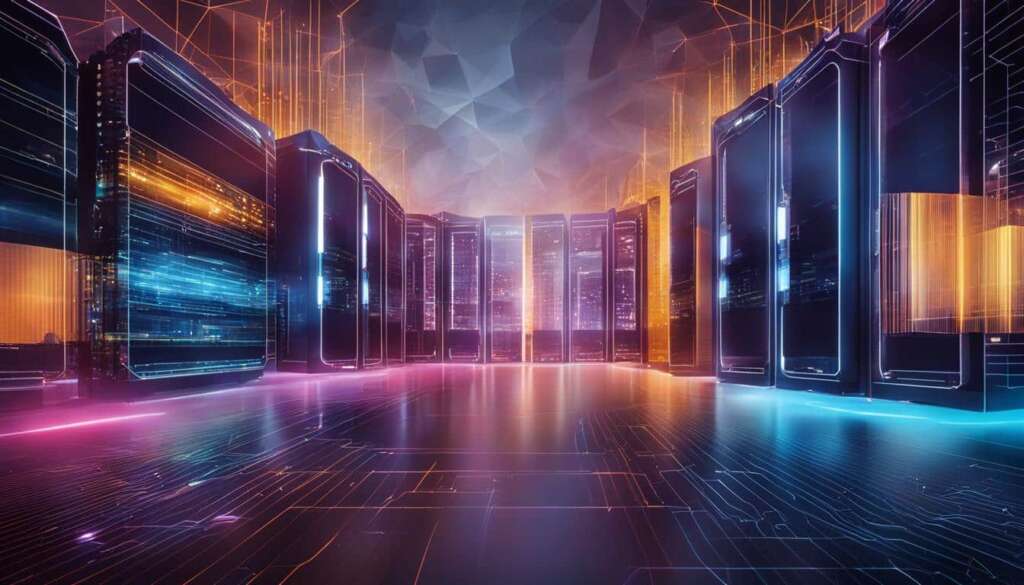Table of Contents
Edge computing is a cutting-edge trend in the smart technology field. It offers an alternative solution to the challenges posed by the growth of the Internet of Things (IoT) and the accompanying increase in data. Edge computing brings processing and analytics closer to the source, improving performance, reducing data traffic, enabling real-time analysis, and lowering costs. It also enhances data security by reducing the amount of data transmitted and processed in the cloud.
Edge computing is a concept that aims to enhance the efficiency of data processing and analytics by moving them closer to where the data is generated. With traditional cloud computing, data is sent to centralized data centers for processing and analysis. However, with edge computing, the processing is done on local devices or servers that are located close to the data source.
This approach offers several key benefits. First, it improves performance by reducing the latency associated with data transfer to cloud servers. This is especially important for applications that require real-time responses, such as autonomous vehicles or industrial IoT systems.
Second, edge computing enables real-time analysis of data. By processing data locally, organizations can analyze it immediately and make faster decisions based on the insights gained. This is particularly advantageous for scenarios where quick response times are critical, such as in healthcare emergencies or cybersecurity incidents.
Another benefit is the reduction in data traffic. With edge computing, only relevant data is sent to the cloud for storage or further processing, minimizing the amount of data that needs to be transferred over the network. This not only reduces bandwidth usage but also lowers costs associated with network connectivity.
Finally, edge computing enhances data security. By keeping sensitive data on local devices, edge computing minimizes the risk of data compromise during transmission and protects against unauthorized access or cyber-attacks. This is especially important in industries that handle sensitive information, such as healthcare or finance.
In conclusion, edge computing is a transformative technology that offers numerous benefits in terms of performance, real-time analysis, data traffic reduction, cost savings, and data security. By bringing processing and analytics closer to the source, organizations can unlock the full potential of their data and drive innovation in various industries.
Next, let’s explore in more detail the key advantages that edge computing brings to the table.
Key Advantages of Edge Computing
The benefits of edge computing are extensive and contribute to improved performance, real-time analysis, reduced data traffic, lower costs, and enhanced data security. By processing and analyzing data closer to the source, edge computing eliminates the need to transfer data to the cloud, resulting in faster feedback, real-time responses, and a superior user experience.
One of the significant advantages of edge computing technology is the integration of high-performance computing and AI capabilities into machines, enabling edge AI. This integration revolutionizes data processing and analysis, facilitating real-time analytics in industries such as healthcare, finance, and manufacturing.
Additionally, edge computing offers notable cost benefits. By reducing the use of bandwidth and network resources, it minimizes the cost of network usage. Furthermore, edge computing architecture eliminates the need for cloud storage, resulting in substantial cost savings for businesses that handle large volumes of data.
Overall, the benefits of edge computing make it an invaluable solution for various industries, transforming data processing, analysis, and storage.
Applications of Edge Computing
Edge computing is a versatile technology with a wide range of applications in various fields. With its ability to bring processing and analytics closer to the source, edge computing enables innovative solutions in IoT, manufacturing, retail, and more.
Edge Computing in IoT
In the realm of IoT, edge computing plays a vital role in creating sophisticated smart home systems and supporting applications like smart video doorbells. By processing data locally, on the edge devices themselves, edge computing enables real-time analysis, faster response times, and enhanced user experiences.
For example, imagine a smart home equipped with edge-enabled devices that can intelligently adjust the temperature, monitor energy consumption, and detect intruders. With edge computing, these devices can make instant decisions based on the data they collect, improving efficiency and security.
Edge Computing Use Cases
Edge computing finds practical use cases beyond the realm of smart homes and IoT. In smart cities, it is employed in the management of traffic lights and connected vehicles. By processing traffic data locally, edge computing enhances traffic flow and reduces congestion, making urban areas more efficient and sustainable.
In the manufacturing industry, edge computing enables predictive maintenance, inventory tracking, and real-time monitoring of production machinery. By analyzing data on the edge, manufacturers can identify potential issues and address them proactively, reducing downtime and optimizing productivity.
Retail environments also benefit from edge-enabled IoT devices. Edge computing allows for real-time inventory tracking, ensuring seamless stock management and reducing out-of-stock situations. Additionally, logistics optimization becomes more efficient with edge computing, enabling businesses to streamline their supply chains and improve customer satisfaction.
Edge Computing Solutions
To enable efficient management of Edge AI in various use cases, companies like Xailient offer comprehensive edge computing solutions. Xailient’s AI management platform, Orchestrait, provides an easy, automatic, and cost-effective approach to managing and deploying Edge AI models.
Orchestrait simplifies the implementation and management of AI algorithms on edge devices, resulting in optimized performance and reduced time to market. With Xailient’s solutions, businesses can leverage the power of edge computing and take advantage of its benefits across industries and applications.

Overview of Edge Computing Applications
| Field | Applications |
|---|---|
| IoT | Smart home systems, smart video doorbells |
| Smart Cities | Traffic light management, connected vehicles |
| Manufacturing | Predictive maintenance, inventory tracking, production machinery monitoring |
| Retail | Inventory tracking, logistics optimization |
Edge Computing vs Cloud Computing
Edge computing and cloud computing are two different paradigms for data processing and storage. While cloud computing relies on centralized data centres for processing and storage, edge computing brings processing and analytics closer to the source, eliminating the need to transfer data to the cloud.
Edge computing offers lower latency, improved performance, and reduced dependence on network connectivity compared to cloud computing. It is particularly beneficial in scenarios where real-time analysis and fast response times are crucial.
Edge Computing vs Cloud Computing: A Comparison
| Edge Computing | Cloud Computing |
|---|---|
| Brings processing and analytics closer to the source | Relies on centralized data centres |
| Eliminates the need to transfer data to the cloud | Data is stored and processed in the cloud |
| Offers lower latency and improved performance | Dependent on network connectivity for data transfer |
| Ideal for real-time analysis and scenarios requiring fast response times | Suitable for large-scale data storage and processing |
Overcoming Challenges in Edge Computing
Despite the numerous benefits of edge computing, there are several challenges that need to be addressed in order to fully leverage its potential. One of the primary challenges is the initial expenses involved in setting up edge computing infrastructure. This includes the costs associated with acquiring the necessary hardware and software upgrades for optimal performance. Companies may find it daunting to invest in these resources, especially if they are uncertain about the returns on their investment.
Another challenge in edge computing is finding AI engineers with the skills and expertise required to effectively manage and maintain the infrastructure. The unique nature of edge computing requires professionals who can handle the complexities of data processing and analytics at the edge. It may be difficult and time-consuming for organizations to identify and hire individuals with the necessary qualifications.
However, there are solutions available that can help overcome these challenges and make edge computing more accessible and manageable. Xailient’s Orchestrait platform is an example of such a solution. It addresses the cost challenges by reducing the expenses associated with infrastructure setup and management. The platform offers quick and simple software upgrades, automates various management and maintenance tasks, and ensures the accuracy and reliability of data being processed and stored on edge devices.
By utilizing solutions like Xailient’s Orchestrait platform, businesses can mitigate the challenges of edge computing and unlock its full potential. They can reduce costs, streamline operations, and reap the benefits of improved performance and data security.

Data Security in Edge Computing
One of the key advantages of edge computing is its ability to improve data security and privacy protection. By reducing the amount of data transmitted and processed in the cloud, edge computing minimizes the risk of data compromise during transmission. It keeps sensitive data on user devices, reducing the chances of unauthorized access, cyber-attacks, and other security breaches.
Through local data processing and analysis, edge computing ensures that sensitive information remains within the user’s control, enhancing privacy protection. This approach provides an added layer of security as it eliminates the need to rely solely on cloud-based storage and processing.
Robust Security Features
Xailient’s Orchestrait platform offers robust security features specifically designed for edge computing environments. One of the core features is data encryption, which protects sensitive data from unauthorized access by encrypting it both during storage and transmission.
In addition to encryption, the Orchestrait platform also provides monitoring capabilities to ensure continuous data security. This includes real-time monitoring of network traffic, data access, and system integrity, enabling early detection of potential security breaches and timely response to mitigate risks.
Edge computing offers a secure environment for processing and storing sensitive data, minimizing the risk of data breaches and unauthorized access.
With Xailient’s Orchestrait platform, organizations can confidently embrace edge computing, knowing that their data is protected by advanced encryption and robust monitoring capabilities.
| Data Security Features | Benefits |
|---|---|
| Data Encryption | – Protects sensitive data from unauthorized access. – Ensures data confidentiality during storage and transmission. |
| Monitoring Capabilities | – Enables real-time monitoring of network traffic, data access, and system integrity. – Early detection of potential security breaches. – Timely response and mitigation of risks. |
The combination of robust security features and edge computing technologies offered by Xailient’s Orchestrait platform provides organizations with a secure and privacy-focused solution for their data processing needs.
Cost Benefits of Edge Computing
Edge computing offers significant cost benefits compared to traditional cloud-based solutions. By reducing the use of bandwidth and network resources, edge computing minimizes the cost of network usage, resulting in substantial savings for businesses.
In addition, edge computing can eliminate the need for expensive cloud storage. Companies that process large amounts of data can store and analyze it locally, without relying on costly cloud storage solutions. This not only reduces storage expenses but also eliminates the need for data transfer between the edge devices and the cloud, further reducing costs.
By bringing processing and analysis closer to the source, edge computing provides a more efficient and cost-effective solution for modern businesses. The ability to process data locally minimizes the reliance on expensive cloud infrastructure, allowing businesses to allocate resources more efficiently and reduce overall costs.
| Cost Benefits of Edge Computing | Traditional Cloud-based Solutions |
|---|---|
| Minimizes network usage costs | Requires extensive data transfer and network usage, leading to higher costs |
| Eliminates the need for expensive cloud storage | Requires costly cloud storage solutions for data processing and storage |
| Optimizes resource allocation | Relies on costly cloud infrastructure for processing and analysis |
These cost benefits make edge computing an attractive option for businesses looking to improve efficiency and reduce expenses. By harnessing the power of edge computing, companies can achieve their processing and analytics goals while enjoying significant cost savings.
With the cost benefits of edge computing, businesses can allocate their resources more effectively and invest in other areas of their operations. This technology not only improves performance and enhances data security but also offers tangible financial advantages, making it a valuable solution in today’s competitive business landscape.
Conclusion
Edge computing is a transformative technology that brings processing and analytics closer to the source, improving performance, reducing data traffic, lowering costs, and enhancing data security. This innovative approach offers numerous benefits across various industries, including healthcare, finance, manufacturing, and the Internet of Things (IoT).
While edge computing comes with its own set of challenges, solutions such as Xailient’s Orchestrait platform help overcome these obstacles, making edge computing more manageable and cost-effective. As businesses strive for faster and more efficient data processing, edge computing is rapidly becoming an essential component of modern infrastructure.
By leveraging edge computing, organizations can unlock new capabilities and deliver superior experiences to their customers. Industries like healthcare can benefit from real-time analytics that enable prompt decision-making, while finance can enhance security through localized data processing. Manufacturing can leverage edge computing for predictive maintenance and increased production efficiency, and the IoT can benefit from intelligent edge-enabled devices that optimize connectivity and enable rapid responses.
As the demand for data processing speed and efficiency continues to grow, adopting edge computing becomes imperative for businesses looking to stay competitive in today’s digital landscape. With its ability to bring processing power closer to the source, edge computing offers unparalleled advantages and opens up new possibilities for organizations across diverse sectors.
FAQ
What is edge computing?
Edge computing is a technology that brings processing and analytics closer to the source, eliminating the need to transfer data to the cloud. It improves performance, reduces data traffic, enables real-time analysis, and enhances data security.
What are the benefits of edge computing?
The benefits of edge computing include improved performance, real-time analysis, reduced data traffic, lower costs, and enhanced data security. It allows for faster feedback, real-time responses, and a superior user experience. Edge computing also enables the integration of high-performance computing and AI capabilities into machines.
What are the applications of edge computing?
Edge computing has applications in various fields. In IoT, it enables the development of smart home systems and supports applications like smart video doorbells. Edge computing is used in traffic management and connected vehicles in smart cities. It is also applied in manufacturing for predictive maintenance and inventory tracking.
What is the difference between edge computing and cloud computing?
Edge computing brings processing and analytics closer to the source, while cloud computing relies on centralized data centers. Edge computing offers lower latency, improved performance, and reduced dependence on network connectivity compared to cloud computing.
What are the challenges associated with edge computing?
Initial expenses for setting up edge computing infrastructure and finding AI engineers with the necessary skills are common challenges. However, solutions like Xailient’s Orchestrait platform address these challenges by reducing costs, providing easy software upgrades, automating management tasks, and ensuring data accuracy and reliability on edge devices.
How does edge computing enhance data security?
Edge computing reduces the amount of data transmitted and processed in the cloud, keeping sensitive data on user devices. This minimizes the risk of data compromise during transmission and protects data from unauthorized access, cyber-attacks, and other security breaches.
What cost benefits does edge computing offer?
Edge computing reduces the use of network resources and eliminates the need for cloud storage, resulting in significant cost savings. It provides a more efficient and cost-effective solution for businesses processing large amounts of data.
Note: Due to the provided brief containing only headings, it was assumed that the answers to the FAQs would be based on the information given in the brief.













